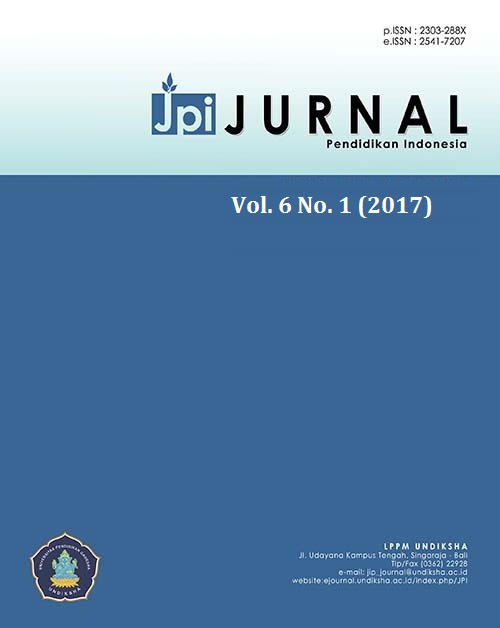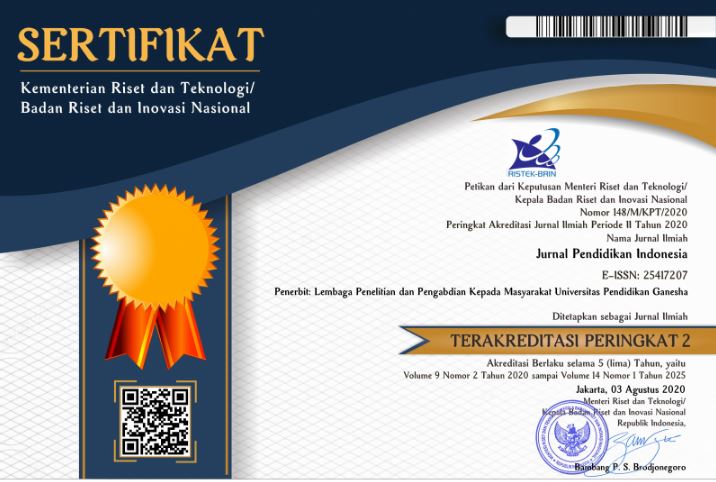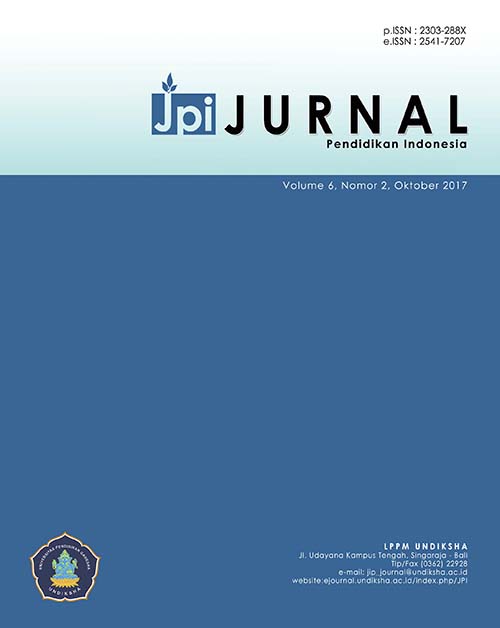EKSPLORASI KEMAMPUAN SISWA KELAS IV SEKOLAH DASAR DALAM PENYELESAIAN SOAL CERITA MATEMATIKA
DOI:
https://doi.org/10.23887/jpi-undiksha.v6i1.9184Keywords:
learning difficulties, math, story problem, strategyAbstract
The objectives for this research are (1) to explore student’s strategies to solve story problem about measurement material; (2) to explore student’s learning difficulties to solve story problem. Subject of this research were 18 of fourth grade students of SDN Winduhaji in Kuningan subdisctrict. This research using qualitative approach within case study method. Data in this research using qualitative namely result of story problem. Techniques of collecting data in this research are using test, interview, and document analysis. Data analyzed by using thematic analisys meanwhile data validated by using triangulation, member checking, and reflectivity. The results of this research show that student’s strategies to solve story problem are (1) using pictures; (2) using diagram; (3) typed problem using addition, reduction, multiplication, and dividing operation. Student’s learning difficulties to solve problem story are (1) problem comprehension difficulties; (2) difficult to representation the problem conductes math and pictures; (c) concept comprehension difficulties; (d) difficult to develop solving strategies; (e) student’s cognitive disruption.
References
Abdurrahman, M. 2012. Anak berkesulitan belajar: teori, diagnosis, dan remediasinya. Jakarta: Rineka Cipta.
Adjie, N. & Maulana. (2006). Pemecahan masalah matematika. Bandung: UPI Press.
Alwasilah, C. 2009. Pokoknya kualitatif dasar-dasar merancang dan melakukan penelitian kualitatif. Jakarta: Pustaka Jaya.
Aydoğdu, M. Z. 2014. A research on geometry problem solving strategies used by elementary mathematics teacher candidate. Journal of Educational and Instructional Studies in The World, 7 (4): 53-62.
Cohen, L., Manion, L., and Marrison, K. 2007. Research in education sixth edition. Newyork: Routledge.
Creswell, J.W. 2013. Research design: Pendekatan kualitatif, kuantitatif, dan mixed. Terjemahan oleh Achmad Fawaid dan Rianayati 2013. Yogyakarta: Pustaka Pelajar.
Creswell, J.W. 2015. Riset pendidikan perencanaan, pelaksanaan, dan evaluasi riset kualitatif dan kuantitatif edisi kelima. Terjemahan oleh Soetjipto H.P. dan Soetjipto S.M. 2015. Yogyakarta: Pustaka Pelajar.
Crowe, S., dkk. (2011). The case study approach. BMC Medical Research Methodology: 11(1): 100.
Denzin, N.K. & Lincoln, Y.S. 2009. Handbook of qualitative research. Terjemahan oleh Dariyatno, Fata B.S., Abi, & Rinaldi, 2009. Yogyakarta: Pustaka Pelajar.
Haylock, D. & Anne C. 2013. Understanding mathematics for young children 4th Edition. London: SAGE.
Huda, N. & Angel G. 2013. Analisis kesulitan siswa berdasarkan kemampuan pemahaman dalam menyelesaikan soal cerita pada materi kubus dan balok di kelas VIII SMP Negeri 30 Muaro Jambi. Prosiding Seminarta FMIPA Universitas Lampung. Lampung: UNILA.
Khabibah, S. & Teguh W. 2016. Analisis kemampuan pemecahan masalah matematika siswa SMP berdasarkan langkah Polya. Diakses dari http://ejournal.umpwr.ac.id/index.php/ekuivalen/article/download/2890/2715.
Mutaqin, E.J. (2013). analisis learning trajectory matematis dalam konsep perkalian bilangan cacah di kelas rendah sekolah dasar. Tesis tidak diterbitkan. Bandung: SPS UPI.
NAEP. (2011). The Nation's Report Card: Mathematic 2011. [Online]. Diakses dari https://nces.ed.gov/nationsreportcard/pubs/main2011/2012458.aspx
Naughton, G.M & Hughes, P. 2009. Doing action research in early childhood studies: A step by step guide. USA: Open University Press.
Polya. 1957. How to solve it. Diakses dari http://math.hawaii.edu/home/pdf/putnam/PolyaHowToSolveIt.pdf.
Putra, N. & Dwilestari, N. 2012. Penelitian kualitatif PAUD pendidikan anak usia dini. Jakarta: Raja Grafindo Persada.
Salimi, M. 2013. Analisis learning trajectory matematika dalam konsep penjumlahan pada siswa kelas rendah sekolah dasar. Tesis tidak diterbitkan. Bandung: SPS UPI.
Suganda, V. A. (2014). Analisis kesulitan dalam menyelesaikan soal pemecahan masalah dan sikap matematis siswa kelas V sekolah dasar. (Tesis). Sekolah Pascasarjana, Universitas Pendidikan Indonesia, Bandung.
Sumarwati. 2013. Soal cerita dengan bahasa komunikatif untuk meningkatkan kualitas pembelajaran matematika sekolah dasar. Jurnal Ilmu Pendidikan. Jilid 1 Nomor 19.
Van De Walle, J. A. 2010. Elementary and middle school mathematics teaching developmentally. Boston: Pearson Edition.
Wahyudin. 2008. Pembelajaran dan model-model pembelajaran (pelengkap untuk meningkatkan kompetensi pedagogis para guru dan calon guru profesional. Bandung: UPI.
Alawiyah, Tuti. 2014. “Pembelajaran untuk Meningkatkan Kemampuan Komunikasi dan Pemecahan Masalah Matematik”. Makalah Disajikan dalam Prosiding Seminar Nasional Pendidikan Matematika Program Pasca Sarjana STKIP Siliwangi Bandung1: 180-187.
Dewi, Sari K., Md Suarjana, dan Md Sumantri. 2014. “Penerapan Polya untuk Meningkatkan Hasil Belajar dalam Memecahkan Soal Cerita Matematika Siswa Kelas V”. Jurnal Mimbar PGSD Universitas Pendidikan Ganesa 1(2).
Erliani, Eneng., Eli Rohmatullaeli, dan Nanang. 2011. “Pembelajaran untuk Meningkatkan Kemampuan Membuat Model Matematika dari Soal Cerita”. Jurnal PTK Khusus(1):1-6.
Lestari, Nur I., Anton Noornia, dan Wardani Rahayu. 2010. “Analisis Kemampuan Siswa SD dalam Menerjemahkan Soal Cerita ke dalam Model Matematika dan Penyelesaiannya”. Jurnal Matematika , Aplikasi dan Pembelajarannya 9 (1): 22-34.
Retna, Milda., Lailatul Mubarokah, dan Suhartatik. 2013. “Proses Berpikir Siswa dalam Menyelesaikan Soal Cerita Ditinjau Berdasarkan Kemampuan Matematika (The Student Thinking Process in Solving Math Story Problem)”. Jurnal Pendidikan Matematika STKIP PGRI Sidoarjo 1 (2): 71-82.
White, Allan L. 2005. “Active Mathematics in Classrooms: Finding Out Why Children Make Mistakes –and Then Doing Something to Help Them”. Square One 15(4): 15-19.
Downloads
Published
Issue
Section
License
Authors who publish with the Jurnal Pendidikan Indnesia agree to the following terms:
- Authors retain copyright and grant the journal the right of first publication with the work simultaneously licensed under a Creative Commons Attribution License (CC BY-SA 4.0) that allows others to share the work with an acknowledgment of the work's authorship and initial publication in this journal.
- Authors are able to enter into separate, additional contractual arrangements for the non-exclusive distribution of the journal's published version of the work (e.g., post it to an institutional repository or publish it in a book), with an acknowledgment of its initial publication in this journal.
- Authors are permitted and encouraged to post their work online (e.g., in institutional repositories or on their website) prior to and during the submission process, as it can lead to productive exchanges, as well as earlier and greater citation of published work. (See The Effect of Open Access)








